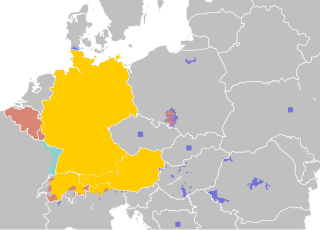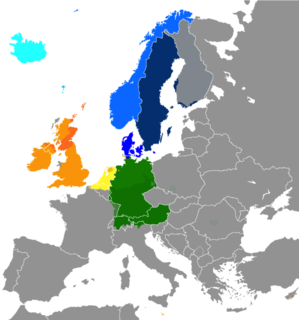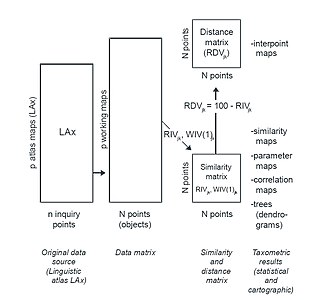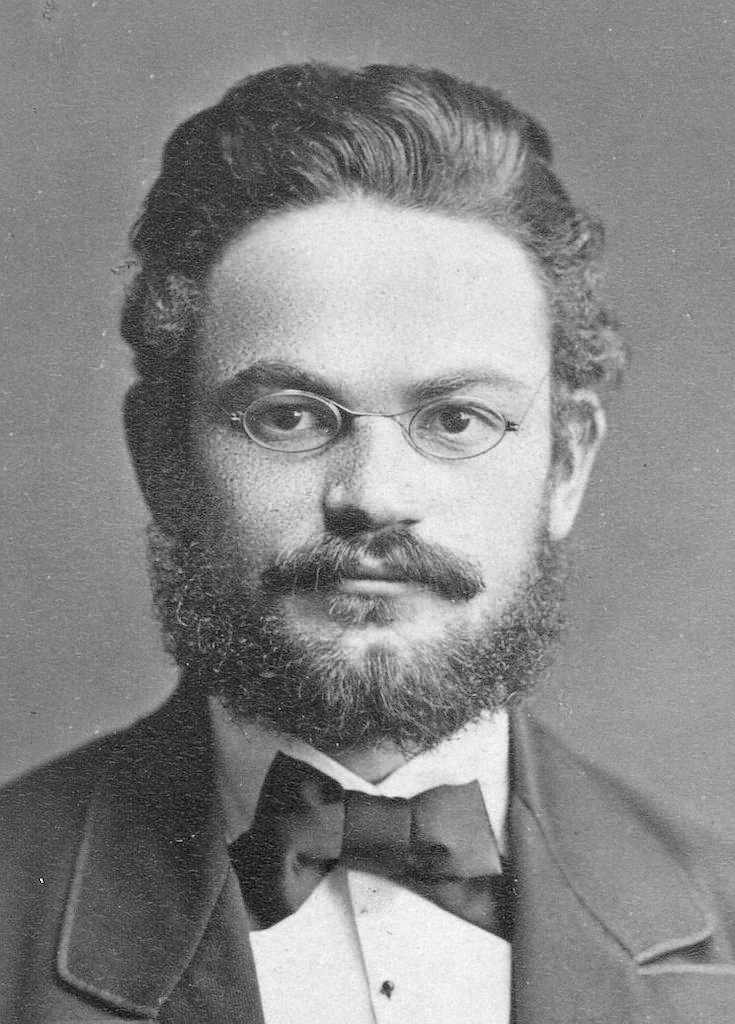
German is a West Germanic language of the Indo-European language family, mainly spoken in Central Europe. It is the most widely spoken and official or co-official language in Germany, Austria, Switzerland, Liechtenstein, and the Italian province of South Tyrol. It is also a co-official language of Luxembourg and Belgium, as well as a national language in Namibia. German is most similar to other languages within the West Germanic language branch, including Afrikaans, Dutch, English, the Frisian languages, Low German, Luxembourgish, Scots, and Yiddish. It also contains close similarities in vocabulary to some languages in the North Germanic group, such as Danish, Norwegian, and Swedish. German is the second most widely spoken Germanic language after English which is also a West Germanic language.
The High German dialects, or simply High German ; not to be confused with Standard High German which is imprecisely also called High German, comprise the varieties of German spoken south of the Benrath and Uerdingen isoglosses in central and southern Germany, Austria, Liechtenstein, Switzerland, Luxembourg, and eastern Belgium, as well as in neighbouring portions of France, Italy, the Czech Republic (Bohemia), and Poland. They are also spoken in diaspora in Romania, Russia, the United States, Brazil, Argentina, Mexico, Chile, and Namibia.

Friedrich Wilhelm Christian Karl Ferdinand von Humboldt was a Prussian philosopher, linguist, government functionary, diplomat, and founder of the Humboldt University of Berlin, which was named after him in 1949.

The West Germanic languages constitute the largest of the three branches of the Germanic family of languages. The West Germanic branch is classically subdivided into three branches: Ingvaeonic, which includes English and Frisian, Istvaeonic, which includes Dutch and its close relatives, and Irminonic, which includes German and its close relatives and variants.
A dialect continuum or dialect chain is a series of language varieties spoken across some geographical area such that neighboring varieties are mutually intelligible, but the differences accumulate over distance so that widely separated varieties may not be. This is a typical occurrence with widely spread languages and language families around the world, when these languages did not spread recently. Some prominent examples include the Indo-Aryan languages across large parts of India, varieties of Arabic across north Africa and southwest Asia, the Turkic languages, the Chinese languages or dialects, and subgroups of the Romance, Germanic and Slavic families in Europe. Leonard Bloomfield used the name dialect area. Charles F. Hockett used the term L-complex.
The Linguasphere Observatory is a non-profit transnational research network, devoted to the gathering, study, classification, editing and free distribution online of the updatable text of a fully indexed and comprehensive Linguasphere Register of the World's Languages and Speech Communities.
Onomasiology is a branch of linguistics concerned with the question "how do you express X?" It is in fact most commonly understood as a branch of lexicology, the study of words.
Dialectology is the scientific study of linguistic dialect, a sub-field of sociolinguistics. It studies variations in language based primarily on geographic distribution and their associated features. Dialectology treats such topics as divergence of two local dialects from a common ancestor and synchronic variation.

Lorraine Franconian is an ambiguous designation for dialects of West Central German, a group of High German dialects spoken in the Moselle department of the former north-eastern French region of Lorraine.
Theodiscus was a term used in the early Middle Ages to refer to the West Germanic languages. The Latin term was borrowed from the Germanic adjective meaning "of the people" but, unlike it, was used only to refer to languages. In Medieval Western Europe non-native Latin was the language of science, church and administration, hence Latin theodiscus and its Germanic counterparts were used as antonyms of Latin, to refer to the "native language spoken by the general populace". They were subsequently used in the Frankish Empire to denote the native Germanic vernaculars. As such, they were no longer used as antonym of Latin, but of walhisk, a language descendant from Latin, but nevertheless the speech of the general populace as well. In doing so Latin theodiscus and the Germanic reflexes of *þiudiskaz effectively obtained the meaning of "Germanic", or more specifically one of its local varieties – resulting in the English exonym "Dutch", the German endonym Deutsch, the modern Dutch word for "German", Duits, and older Dutch words for Dutch and German and their dialects Diets, and Duuts. In Romance languages the same word yielded the Italian word for "German", tedesco, and the old French word used for Dutch or, depending on the locality, German speakers, tiois.

German dialects are the various traditional local varieties of the German language. Though varied by region, those of the southern half of Germany beneath the Benrath line are dominated by the geographical spread of the High German consonant shift, and the dialect continuum that connects German to the neighboring varieties of Low Franconian (Dutch) and Frisian.

Dialectometry is the quantitative and computational branch of dialectology, the study of dialect. This sub-field of linguistics studies language variation using the methods of statistics; it arose in the 1970s and 80s as a result of seminal work by J. Séguy and Hans Goebl.
Swiss Standard German, or Swiss High German, referred to by the Swiss as Schriftdeutsch, or Hochdeutsch, is the written form of one of four official languages in Switzerland, besides French, Italian and Romansh. It is a variety of Standard German, used in the German-speaking part of Switzerland and Liechtenstein. It is mainly written, and rather less often spoken.
Anglo-Norman, also known as Anglo-Norman French, was a dialect of Old Norman French that was used in England and, to a lesser extent, elsewhere in Great Britain and Ireland during the Anglo-Norman period.

Georg Wenker was a German linguist who began documenting German dialect geography during the late nineteenth century. He is considered a pioneer in this field and contributed several groundbreaking publications, most notably, the Deutscher Sprachatlas.

Upper German is a family of High German dialects spoken primarily in the southern German-speaking area.
Duli is an extinct Adamawa language of northern Cameroon.
Max Leopold Wagner was a German philologist and ethnologist, particularly known for his studies on the Sardinian language. He also carried out pioneering research on the Spanish language in Hispanic America. In a posthumous review of his three-volume Dizionario etimologico sardo, Ernst Pulgram wrote: It can only be hoped that ... there will arise ... men like Wagner: original thinkers, deep specialists, and great synthesizers of knowledge all at the same time.

The Atlas linguistique de la France is an influential dialect atlas of Romance varieties in France published in 13 volumes between 1902 and 1910 by Jules Gilliéron and Edmond Edmont. Whereas Georg Wenker had used postal questionnaires to compile his pioneering Sprachatlas des deutschen Reichs in 1888, Gilliéron employed a fieldworker, Edmond Edmont. Between 1896 and 1900, Edmont conducted 700 interviews at 639 locations throughout the countryside of France, southern Belgium, western Switzerland, the Channel Islands, and the Aosta Valley and the Occitan Valleys of Piedmont in Italy, using a questionnaire of over 1,500 items devised and continually revised by Gilliéron. The results were collated and analysed by Gilliéron and his assistants.
Karl Jaberg was a Swiss linguist and dialectologist.










